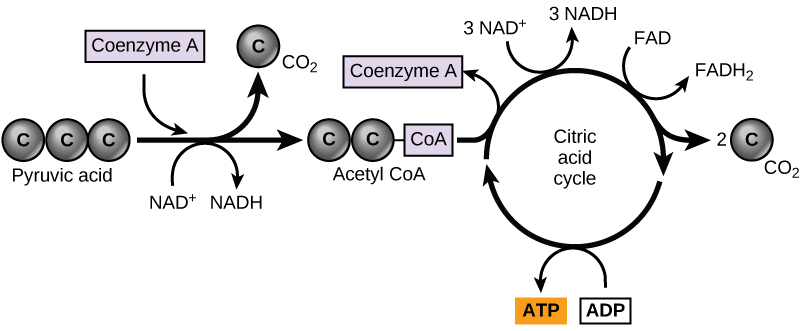In eukaryotic cells, the pyruvate molecules produced at the end of glycolysis are transported into mitochondria. Mitochondria are sites of cellular respiration; In the presence of oxygen, aerobic respiration will proceed. In the mitochondria, pyruvate is first transformed into a two-carbon acetyl group by removing a molecule of carbon dioxide. This acetyl group is attached to a carrier compound called coenzyme A (CoA), which is made from vitamin B5. The resulting 2-carbon compound is called acetyl CoA. (Figure 8.51). Acetyl CoA can be used in a variety of ways by the cell, but its major function is to deliver the acetyl group derived from pyruvate to the next pathway in glucose catabolism.

Like the conversion of pyruvate to acetyl CoA, the citric acid cycle in eukaryotic cells takes place in the matrix of the mitochondria. Unlike glycolysis, the citric acid cycle is a closed loop: The last part of the pathway regenerates the compound used in the first step. The eight steps of the cycle are a series of chemical reactions that produces the following from each molecule of pyruvate (remember that there are 2 molecules of pyruvate produced per molecule of glucose that originally went into glycolysis):
- 2 carbon dioxide molecules
- 1 ATP molecule (or an equivalent)
- 3 NADH and 2 FADH2, which carry energy to the last part of the aerobic respiration pathway.
Part of this is considered an aerobic pathway (oxygen-requiring) because the NADH and FADH2 produced must transfer their electrons to the next pathway in the system, which will use oxygen. If oxygen is not present, this transfer does not occur. The citric acid cycle does NOT occur in the absence of oxygen.
The citric acid cycle is also sometimes called the TCA cycle or the Krebs cycle. These names can be used interchangeably – they all refer to the same process.
More Details
Two carbon atoms come into the citric acid cycle from each acetyl group. Two carbon dioxide molecules are released on each turn of the cycle; however, these do not contain the same carbon atoms contributed by the acetyl group on that turn of the pathway. The two acetyl-carbon atoms will eventually be released on later turns of the cycle; in this way, all six carbon atoms from the original glucose molecule will be eventually released as carbon dioxide. It takes two turns of the cycle to process the equivalent of one glucose molecule. Each turn of the cycle forms three high-energy NADH molecules and one high-energy FADH2 molecule. These high-energy carriers will connect with the last portion of aerobic respiration to produce ATP molecules. One ATP (or an equivalent) is also made in each cycle. Several of the intermediate compounds in the citric acid cycle can be used in synthesizing non-essential amino acids; therefore, the cycle is both anabolic and catabolic.

